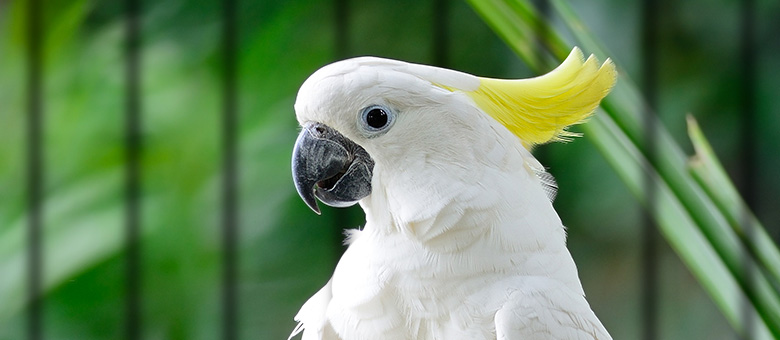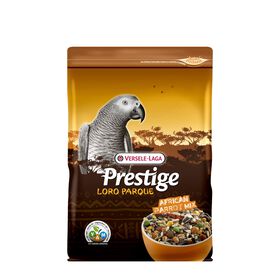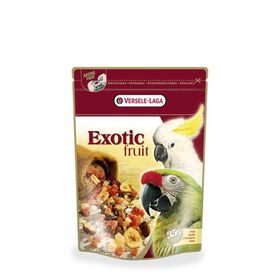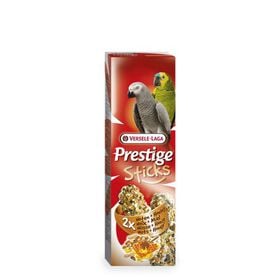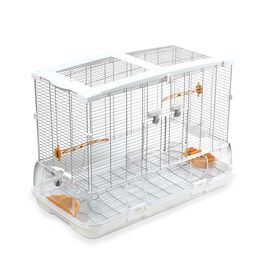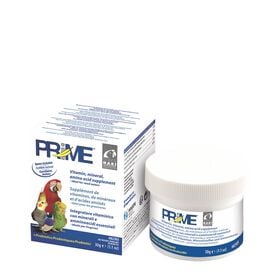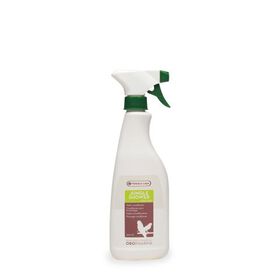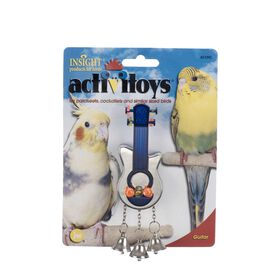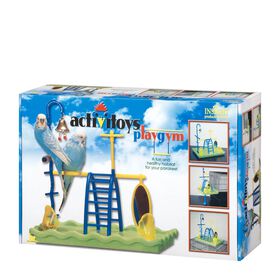Exotic birds are gregarious animals and some species can live for up to 40 years. They are genetically programmed to fly and live amongst others of their kind.
Birds amaze us. Their beauty. Their intelligence. The way they organize themselves in social situations. The immense musical talent of certain species or their ability to imitate sounds and human voices. Parrots are
trained to be social creatures — they are not domesticated birds — and their life expectancy is close to that of humans.
Over the past few decades, psittacines (parrots and budgies) have become more and more popular as house pets. Private breeders are also becoming increasingly common, and this has given rise to an entire market of products to respond to their domestic needs.
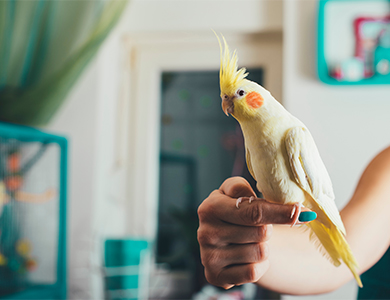
Life with a bird
Want to know how you can meet your birds’ biological needs, keep them chirping, in order that everyone can live happily together?
You’ll quickly notice that parrots aren’t the easiest animals to live with and probably require the most care. They also happen to have the most needs and the highest non-negotiable financial investment. Passerines (finches and canaries) are often excellent singers and don’t make too much noise. These petite-frame creatures are dynamic, have an unparalleled joie de vivre, and are independent. But they aren’t easily domesticated. As a result, they are less demanding than psittacines. Observing them and listening to them is an amazing experience for those lucky enough to have the opportunity.
Making the choice
Although you’ll often be told that it is wise to take your time and consider your lifestyle habits before choosing a pet, love at first sight does exist and will continue to exist, and this is unfortunately too often the case when it comes to “caged” and “aviary” birds.
Once you’ve made your choice, you must consider where you’re going to get the animal. You can consult a breeder directly, or visit a pet store. You may also want to seriously consider buying the animal in a shelter — they are often overloaded with abandoned birds who desperately need a second chance.
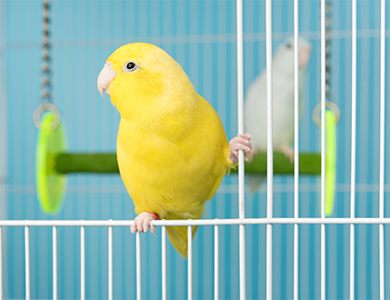
The first days with your new feathered friend
The first days after you’ve adopted a bird will, in all likelihood, be very calm, because the bird will spend a lot of time observing their new environment and studying your habits methodically before adapting to their “universe,” which also happens to be your own. You must allow them the time to properly study their new environment at their own pace. But be sure that things go back to “business as usual.”
Remember that birds are naturally highly active, curious, fun, sociable and intelligent. You must therefore always try your best to be creative in order to nourish their intellectual and emotional needs. The living environment must be adapted to the needs of each species. The bigger their beak, the stronger the snap, and when it comes to letting us know what they need, they’ll do so by biting. Furthermore, don’t forget that birds don’t do well with boredom: they can easily become self-destructive and depressed.
Everything is better in twos!
“Gregarious” is a descriptive which is often mentioned in the same breath as birds and parrots. The Larousse dictionary defines it as “a species of animal which lives in groups or communities, but without any social structure.” This means that birds, parrots, are happy in groups. They are not solitary. They must live amongst peers.
This is an important point that must be considered. The same goes for a number of domestic species. On the other hand, certain birds who need their feathers cleaned must cohabitate with a member of their species. It is not recommended that a human play this role. Though frequently seen, this type of situation leads to a lot of difficulties between the person and the bird, and all too often leads to the bird being abandoned after developing too heavy a dependence on their preferred human. Birds are loyal creatures. Many species of psittacines stay in partnerships forever.
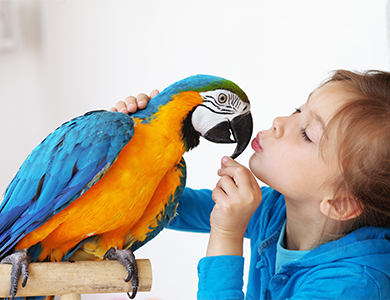
Give them some freedom
Birds represent freedom. The sky belongs to them, and we cannot give them their liberty. In order to better cohabitate with these majestic creatures, we must keep them in cages and ensure they seldom leave our homes.
Contrary to the centuries-old image of the caged bird, these feathered creatures need to be liberated. Restricting them to a cage shows we want to keep them as a pet, which goes against their nature.
You should therefore seriously consider how you will allow your bird to fly safely within defined boundaries specifically reserved for flying and playing.
Even with their flight feathers trimmed, birds know that they are capable of flying.
A bird with clipped wings is still going to flap its wings. Birds thus require sufficient space, not only to spread their wings, but to play, move, eat and destroy! (Sidenote: “Playing” and “destroying” often mean the same thing to birds.)
The cage-playground environment is highly important - as much for you as for your birds. The degree to which you respond to their needs will directly determine how well you cohabitate. Don’t forget which type of bird you are considering. The larger they are, the more play space they will require.
That said, the reverse isn’t necessarily true: small birds can fly just as high as large birds — just consider the distance a hummingbird can cover between different countries. The same goes for canaries and finches.
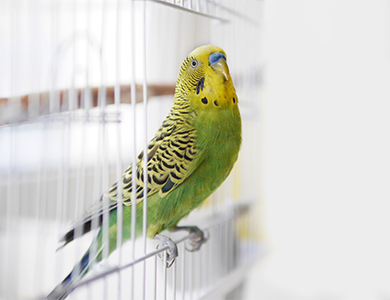
A solid starter kit
Other than these main points to keep in mind when looking to take on a bird as a pet, there are other highly important points to consider in order to make your living experience more enjoyable. In addition to opting for the appropriate cage and accessories, having a vast selection of toys to attract and hold their interest is highly important. The domestic bird starter kit must therefore feature all these items, in addition to a healthy diet that includes fresh produce (fruits and vegetables), grains, and a mixture of feed and extruded granules, depending on the species.
Behaviour
Birds are loyal animals, but also impatient and punctual. These qualities have a number of consequences for the humans with whom they cohabitate. They find security in their routine. It is thus very difficult for a bird to change living arrangements repeatedly. Their immense talent for observing new situations might lead one to believe that birds adapt well to new situations. But the reality is, these new situations cause them a great deal of stress. Don’t forget their secretive nature: they are prey and are thus inclined to be fearful and always ready to fly away in order to remove themselves from danger.
Misinterpreting birds’ behaviour often leads to them being abandoned. Birds are mistreated just as often as other domestic animals. Keeping them captive often brings about undesirable behaviour. They can be easily mistreated. This is why their needs, and specifically their need to fly, must come first when they are being kept in captivity.
Happily ever after
The longevity of these animals, and their specific individual needs, are factors which all too often cause owners to abandon them for reasons related to health, ageing, or a failure to understand their needs.
Therefore, it is important to always consider the future of these pets. Even if you leave them in the hands of a third party on a long-term basis, remember that this person will also be affected by their precarious nature.
In closing, before you take on a domestic bird as a pet, take the time to consider all that is involved in doing so, so that you can make the right choice. There are a number of factors to consider in order to ensure that their life, like yours, will be lived happily ever after.
References:
Keelty, Lisa. “Birds as Pets” / “A Basic Guide on Choosing a Cage for Your Pet Bird” / “Cage Accessories and Cleaning”.
Simoneau, Jacqueline. “Comment choisir un oiseau de compagnie”.
Tremblay, Manon, DVM. “Choisir un oiseau”.
Tremblay, Manon, DVM. Les perroquets en 100 questions. Éditions La Griffe.
Truffaut. “Comment bien vivre avec vos canaris”.
Vaillancourt, Johanne. “Le perroquet, un animal hautement sociable”.
WikiHow. “How to Care for a Bird”.
Video Illustrations:
Passerine: Our New Pet Bird.
Psittacines: Companion Parrots.
Examples of drawbacks: Deterring Our New Budgies.
Keep soaring!
Danyèle Vachon and Claire Versailles
